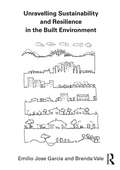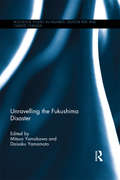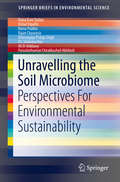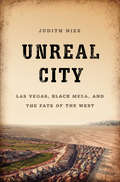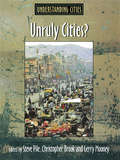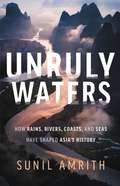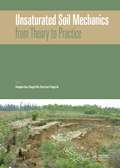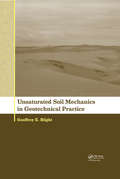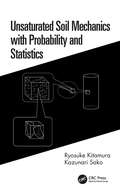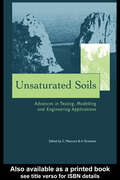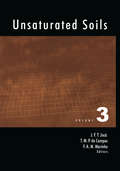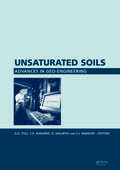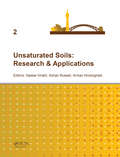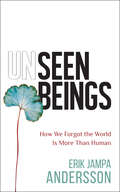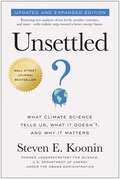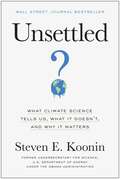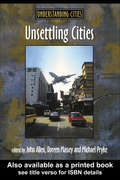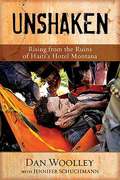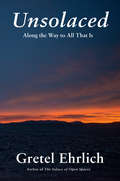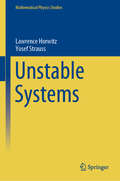- Table View
- List View
Unravelling Sustainability and Resilience in the Built Environment
by Brenda Vale Emilio Jose GarciaIn this timely book, Emilio Jose Garcia and Brenda Vale explore what sustainability and resilience might mean when applied to the built environment. Conceived as a primer for students and professionals, it defines what the terms sustainability and resilience mean and how they are related to each other and to the design of the built environment. After discussion of the origins of the terms, these definitions are then compared and applied to case studies, including Whitehill and Bordon, UK, Tianjin Eco-city, China, and San Miguel de Tucuman, Argentina, which highlight the principles of both concepts. Essentially, the authors champion the case that sustainability in the built environment would benefit from a proper understanding of resilience.
Unravelling the Fukushima Disaster (Routledge Studies in Hazards, Disaster Risk and Climate Change)
by Mitsuo Yamakawa Daisaku YamamotoThe Fukushima disaster continues to appear in national newspapers when there is another leakage of radiation-contaminated water, evacuation designations are changed, or major compensation issues arise and so remains far from over. However, after five years, attention and research towards the disaster seems to have waned despite the extent and significance of the disaster that remains. The aftermath of Fukushima exposed a number of shortcomings in nuclear energy policy and disaster preparedness. This book gives an account of the municipal responses, citizen’s responses, and coping attempts, before, during, and after the Fukushima crisis. It focuses on the background of the Fukushima disaster, from the Tohoku earthquake to diffusion on radioactive material and risk miscommunication. It explores the processes and politics of radiation contamination, and the conditions and challenges that the disaster evacuees have faced, reflecting on the evacuation process, evacuation zoning, and hope in a post-Fukushima environment. The book will be of great interest to students and scholars of disaster management studies and nuclear policy.
Unravelling the Soil Microbiome: Perspectives For Environmental Sustainability (SpringerBriefs in Environmental Science)
by Dhananjaya Pratap Singh Ratna Prabha Purushothaman Chirakkuzhyil Abhilash Rama Kant Dubey Vishal Tripathi Rajan Chaurasia Ch. Srinivasa Rao Ali El-KeblawyThis book explores the significance of soil microbial diversity to understand its utility in soil functions, ecosystem services, environmental sustainability, and achieving the sustainable development goals. With a focus on agriculture and environment, the book highlights the importance of the microbial world by providing state-of-the-art technologies for examining the structural and functional attributes of soil microbial diversity for applications in healthcare, industrial biotechnology, and bioremediation studies. In seven chapters, the book will act as a primer for students, environmental biotechnologists, microbial ecologists, plant scientists, and agricultural microbiologists. Chapter 1 introduces readers to the soil microbiome, and chapter 2 discusses the below ground microbial world. Chapter 3 addresses various methods for exploring microbial diversity, chapter 4 discusses the genomics methods, chapter 5 provides the metaproteomics and metatranscriptomics approaches and chapter 6 details the bioinformatics tools for soil microbial community analysis, and chapter 7 concludes the text with future perspectives on further soil microbial uses and applications.
Unreal City: Las Vegas, Black Mesa, and the Fate of the West
by Judith NiesAn epic struggle over land, water, and power is erupting in the American West and the halls of Washington, DC. It began when a 4,000-square-mile area of Arizona desert called Black Mesa was divided between the Hopi and Navajo tribes. To the outside world, it was a land struggle between two fractious Indian tribes; to political insiders and energy corporations, it was a divide-and-conquer play for the 21 billion tons of coal beneath Black Mesa. Today, that coal powers cheap electricity for Los Angeles, a new water aqueduct into Phoenix, and the neon dazzle of Las Vegas. Journalist and historian Judith Nies has been tracking this story for nearly four decades. She follows the money and tells us the true story of wealth and water, mendacity, and corruption at the highest levels of business and government. Amid the backdrop of the breathtaking desert landscape, Unreal City shows five cultures colliding-Hopi, Navajo, global energy corporations, Mormons, and US government agencies-resulting in a battle over resources and the future of the West. Las Vegas may attract 39 million visitors a year, but the tourists mesmerized by the dancing water fountains at the Bellagio don’t ask where the water comes from. They don’t see a city with the nation’s highest rates of foreclosure, unemployment, and suicide. They don’t see the astonishing drop in the water level of Lake Mead-where Sin City gets 90 percent of its water supply. Nies shows how the struggle over Black Mesa lands is an example of a global phenomenon in which giant transnational corporations have the power to separate indigenous people from their energy-rich lands with the help of host governments. Unreal City explores how and why resources have been taken from native lands, what it means in an era of climate change, and why, in this city divorced from nature, the only thing more powerful than money is water.
Unruly Cities?: Order/Disorder
by Steve Pile Chris Brook Gerry MooneyThe text argues that cities are open to many forms of order and disorder both from within the city and outside. They represent cities potentials as well as their problems. It challenges the assumption that cities are threatened by disorder from below and that they might be ruled by 'order' imposed from above.
Unruly Waters: How Rains, Rivers, Coasts, and Seas Have Shaped Asia's History
by Sunil AmrithFrom a MacArthur "Genius," a bold new perspective on the history of Asia, highlighting the long quest to tame its watersAsia's history has been shaped by her waters. In Unruly Waters, historian Sunil Amrith reimagines Asia's history through the stories of its rains, rivers, coasts, and seas--and of the weather-watchers and engineers, mapmakers and farmers who have sought to control them. Looking out from India, he shows how dreams and fears of water shaped visions of political independence and economic development, provoked efforts to reshape nature through dams and pumps, and unleashed powerful tensions within and between nations.Today, Asian nations are racing to construct hundreds of dams in the Himalayas, with dire environmental impacts; hundreds of millions crowd into coastal cities threatened by cyclones and storm surges. In an age of climate change, Unruly Waters is essential reading for anyone seeking to understand Asia's past and its future.
Unsafety
by Shigeo AtsujiThis is the first book to examine the linkages among natural and organizational accidents and disasters in the modern era and clarifies the mechanisms involved and the significance of emerging problems, from the aging of vital infrastructure for the supply of water, gas, oil, and electricity to the breakdown of pensions, healthcare, and other social systems. The book demonstrates how we might check the underlying civilizational collapse and then explore translational systems approaches toward resilient management and policy for sustainability. In Unsafety, the author focuses on the kinds of unnatural disasters and organizational accidents that arise as repercussions of natural hazards. Japan serves as an example, where earthquakes, tsunamis, and typhoons are common, with the Fukushima nuclear disaster as an outstanding case of this link between natural disasters and organizational accidents. Natural and human-made disasters happen worldwide and cause misery through loss of life; destruction of livelihoods as in agriculture, fisheries, and the manufacturing industry; and interruption of urban life. Unsafety from a disaster in one place increases uncertainty elsewhere, presenting urgent issues in all nations for individuals, organizations, regions, and the state. The author explains that one factor in the Fukushima catastrophe, which followed in the wake of the earthquake and tsunami in 2011, was the latent deterioration and aging of systems at all levels from the physical to the social, leading through a chain reaction to unsought and unforeseen consequences. Here, the aging of the nuclear reactor system, the breakdown of safety management, and inappropriate instructions from the regulatory authorities combined to create the three-fold disaster, in which technological, organizational, and governmental dysfunction have been diagnosed as reflecting a "systems pathology" infecting all levels.
Unsaturated Soil Mechanics - from Theory to Practice: Proceedings of the 6th Asia Pacific Conference on Unsaturated Soils (Guilin, China, 23-26 October 2015)
by Changfu Wei Zhenghan Chen De’an Sun Yongfu XuIn the past decades advances have been made in the research and practice on unsaturated soil mechanics. In 2000 the first Asia-Pacific Conferences on Unsaturated Soils was organized in Singapore. Since then, four conferences have been held under the continued support of the Technical Committee on Unsaturated Soils (TC106) of the International Socie
Unsaturated Soil Mechanics in Geotechnical Practice
by Geoffrey E BlightThere are other books on unsaturated soil mechanics, but this book is different. Unsaturated soil mechanics is only one aspect of a continuous range of soil mechanics studies that extends from the rheology of high water content soil slurries to the mechanics of soft soils, to stiff saturated soils, to unsaturated soils, and, at the far end of the r
Unsaturated Soil Mechanics with Probability and Statistics
by Ryosuke Kitamura Kazunari SakoSoil is fundamentally a multi-phase material – consisting of solid particles, water and air. In soil mechanics and geotechnical engineering it is widely treated as an elastic, elastoplastic or visco-elastoplastic material, and consequently regarded as a continuum body. However, this book explores an alternative approach, considering soil as a multi-phase and discrete material and applying basic Newtonian mechanics rather than analytical mechanics. It applies microscopic models to the solid phase and fluid phases, and then introduces probability theory and statistics to derive average physical quantities which correspond to the soil‘s macroscopic physical properties such as void ratio and water content. This book is particularly focused on the mechanical behaviour of dry, partially saturated and full saturated sandy soil, as much of the physicochemical microscopic characteristic of clayey soil is still not clear. It explores the inter-particle forces at the point of contact of soil particles and the resultant inter-particle stresses, instead of the total stress and effective stress which are studied in mainstream soil mechanics. Deformation and strength behaviour, soil-water characteristic curves, and permeability coefficients of water and air are then derived simply from grain size distribution, soil particle density, void ratio and water content. A useful reference for consultants, professional engineers, researchers and public sector organisations involved in unsaturated soil tests. Advanced undergraduate and postgraduate students on Unsaturated Soil Mechanics courses will also find it a valuable text to study.
Unsaturated Soils - Advances in Testing, Modelling and Engineering Applications: Proceedings of the Second International Workshop on Unsaturated Soils, 23-25 June 2004, Anacapri, Italy
by A. Tarantino C. MancusoThis volume contains the Proceedings of the Second International Workshop on Unsaturated Soils, which was held in Anacapri, Italy, from 23 to 25 June 2004. This meeting was organized by the Department of Geotechnical Engineering of the University of Naples Federico II and the Department of Mechanical and Structural Engineering of the University of
Unsaturated Soils - Volume 3: Proceedings of the 3rd International Conference on Unsaturated Soils, UNSAT 2002, 10-13 March 2002, Recife, Brazil
by J.F.T. Jucá; Tácio M.P. de Campos; Fernando A.M. MarinhoUnsaturated materials comprise residua, collapsible and expansive naturally occurring soils, compacted soils and, more recently, residues of solid wastes. The engineering problems associated with unsaturated materials range from those related to conventional geotechnical works (e.g. foundations, pavements, slopes and excavations, retaining structures, earthdams, irrigation canals, tunnelling, compacted embankments) to those included in the environmental area (e.g. natural slope instability, erosion and subsidence processes, tailings, residues or solid waste disposal, contaminant transport, remediation of contaminant sites, engineered barriers for environmental protection, re-use of residues). This book, published in three separate volumes, comprises a selection of selected and invited papers presented at the Third International Conference on Unsaturated Soils – UNSAT ‘2002 – that took place in Recife, Brazil, form 10th to 13th March 2002. The book is of interest to consultants, researchers, practitioners, lecturers and students with a background in geotechnical engineering, environmental engineering and engineering geology.
Unsaturated Soils. Advances in Geo-Engineering: Proceedings of the 1st European Conference, E-UNSAT 2008, Durham, United Kingdom, 2-4 July 2008
by D. G. Toll C. E. Augarde D. Gallipoli S. J. WheelerUnsaturated Soils: Advances in Geo-Engineering comprises 136 contributions from leading international researchers and practitioners, presented at the First European Conference on Unsaturated Soils (Durham, UK, 2-4 July 2008). The papers report on the latest advances in geo-engineering aspects of unsaturated soils. It is the first collection to focu
Unsaturated Soils: Research & Applications
by N. Khalili; A.R. Russell; A. KhoshghalbThis book contains the contributions to the Second European Conference on Unsaturated Soils, E-UNSAT 2012, held in Napoli, Italy, in June 2012, and includes more than one hundred papers, addressing three thematic areas: experimental, modelling, and engineering.
Unseen Beings: How We Forgot the World Is More Than Human
by Erik Jampa Andersson'Unseen Beings is a magnificent, passionate, brilliantly written manifesto for our urgent reimagining of our relationship with every aspect of the creation… indispensable reading for anyone who longs for a just and balanced human future. Buy it and give it to everyone you know.' Andrew Harvey, author of The Hope A revolutionary perspective on the climate catastrophe bridging history, philosophy, science, and religion.You&’ve heard the hard-hitting data and you&’ve seen the documentaries. But what will it truly take for humanity to change? We will not tackle the climate catastrophe with data alone – we need new stories and new ways of seeing and thinking.By drawing on traditional eco-philosophies and Buddhist wisdom, Erik Jampa Andersson offers an approach to our environmental emergency that will make us rethink the very nature of our existence on this incredible planet. Looking at the climate catastrophe through the framework of disease, Unseen Beings examines our ecological diagnosis, its historical causes and conditions and, crucially, its much-needed treatment, as well as exploring:how and why we constructed a human-centric worldview amazing recent discoveries around non-human intelligencehow religious traditions have dealt with questions of nature, sentience and ecologycritical connections between human health and environmental healthThis book is a call to action. Climate anxiety has left many of us feeling confused and powerless, but there is another way. If we can recover our natural sense of enchantment and kinship with non-human beings, we may still find a path to build a better future.
Unseen Danger: A Tragedy of People, Government, and the Centralia Mine Fire
by David DekokAward-winning journalist David DeKok tells, for the first time, how the Centralia mine fire really started in 1962. He shows how local, state and federal government officials failed to take effective action, allowing the fire to move underneath the small town of Centralia, Pennsylvania. By early 1981, the fire was sending deadly gases into homes, forcing the federal government to install gas alarms. A 12-year-old boy dropped into a steaming hole in the ground wrenched open by the fire's heat on Valentine's Day as the region's congressman toured nearby. DeKok tells how the people of Centralia banded together to demand help from the government, finally winning money to relocate much of the town.
Unsettled (Updated and Expanded Edition): What Climate Science Tells Us, What It Doesn't, and Why It Matters
by Steven E. KooninIn this updated and expanded edition of climate scientist Steven Koonin&’s groundbreaking book, go behind the headlines to discover the latest eye-opening data about climate change—with unbiased facts and realistic steps for the future. "Greenland&’s ice loss is accelerating." "Extreme temperatures are causing more fatalities." "Rapid 'climate action' is essential to avoid a future climate disaster." You've heard all this presented as fact. But according to science, all of these statements are profoundly misleading. With the new edition of Unsettled, Steven Koonin draws on decades of experience—including as a top science advisor to the Obama administration—to clear away the fog and explain what science really says (and doesn't say). With a new introduction, this edition now features reflections on an additional three years of eye-opening data, alternatives to unrealistic &“net zero&” solutions, global energy inequalities, and the energy crisis arising from the war in Ukraine. When it comes to climate change, the media, politicians, and other prominent voices have declared that &“the science is settled.&” In reality, the climate is changing, but the why and how aren&’t as clear as you&’ve probably been led to believe. Koonin takes readers behind the headlines, dispels popular myths, and unveils little-known truths: Despite rising greenhouse gas emissions, global temperatures decreased from 1940 to 1970 Models currently used to predict the future do not accurately describe the climate of the past, and modelers themselves strongly doubt their regional predictions There is no compelling evidence that hurricanes are becoming more frequent—or that predictions of rapid sea level rise have any validity Unsettled is a reality check buoyed by hope, offering the truth about climate science—what we know, what we don&’t, and what it all means for our future.
Unsettled: What Climate Science Tells Us, What It Doesn't, and Why It Matters
by Steven E. KooninWALL STREET JOURNAL BESTSELLER 2022 IPPY AWARDS GOLD MEDALIST — SCIENCE NATIONAL INDIE EXCELLENCE AWARDS FINALIST — POLITICAL 2021 WORLD MAGAZINE ACCESSIBLE SCIENCE BOOK OF THE YEAR — HONORABLE MENTION "Unsettled is a remarkable book—probably the best book on climate change for the intelligent layperson—that achieves the feat of conveying complex information clearly and in depth." —Claremont Review of Books &“[Unsettled] is no polemic. It&’s a plea for understanding how scientists extract clarity from complexity.&” — Wall Street Journal "Surging sea levels are inundating the coasts." "Hurricanes and tornadoes are becoming fiercer and more frequent." "Climate change will be an economic disaster." You've heard all this presented as fact. But according to science, all of these statements are profoundly misleading. When it comes to climate change, the media, politicians, and other prominent voices have declared that "the science is settled." In reality, the long game of telephone from research to reports to the popular media is corrupted by misunderstanding and misinformation. Core questions—about the way the climate is responding to our influence, and what the impacts will be—remain largely unanswered. The climate is changing, but the why and how aren't as clear as you've probably been led to believe. Now, one of America's most distinguished scientists is clearing away the fog to explain what science really says (and doesn't say) about our changing climate. In Unsettled: What Climate Science Tells Us, What It Doesn't, and Why It Matters, Steven Koonin draws upon his decades of experience—including as a top science advisor to the Obama administration—to provide up-to-date insights and expert perspective free from political agendas. Fascinating, clear-headed, and full of surprises, this book gives readers the tools to both understand the climate issue and be savvier consumers of science media in general. Koonin takes readers behind the headlines to the more nuanced science itself, showing us where it comes from and guiding us through the implications of the evidence. He dispels popular myths and unveils little-known truths: despite a dramatic rise in greenhouse gas emissions, global temperatures actually decreased from 1940 to 1970. What's more, the models we use to predict the future aren't able to accurately describe the climate of the past, suggesting they are deeply flawed. Koonin also tackles society's response to a changing climate, using data-driven analysis to explain why many proposed "solutions" would be ineffective, and discussing how alternatives like adaptation and, if necessary, geoengineering will ensure humanity continues to prosper. Unsettled is a reality check buoyed by hope, offering the truth about climate science that you aren't getting elsewhere—what we know, what we don't, and what it all means for our future.
Unsettling Cities: Movement/Settlement (Understanding Cities)
by John Allen Doreen Massey Michael PrykeThis text examines the global nature of cities - cities whose openness has shaped their dynamism and character.It explores cities as sites of movement, migration and settlement where different peoples, cultures and environments combine. Unsettling Cities explores the mix of proximity and difference that exists in the rich and diverse texture of city life. The contributors reveal the association between the changing fortunes of cities and the power and influence of global networks.
Unsettling Eurocentrism in the Westernized University (Routledge Research in New Postcolonialisms)
by Julie Cupples Ramón GrosfoguelThe westernized university is a site where the production of knowledge is embedded in Eurocentric epistemologies that are posited as objective, disembodied and universal and in which non-Eurocentric knowledges, such as black and indigenous ones, are largely marginalized or dismissed. Consequently, it is an institution that produces racism, sexism and epistemic violence. While this is increasingly being challenged by student activists and some faculty, the westernized university continues to engage in diversity and internationalization initiatives that reproduce structural disadvantages and to work within neoliberal agendas that are incompatible with decolonization. This book draws on decolonial theory to explore the ways in which Eurocentrism in the westernized university is both reproduced and unsettled. It outlines some of the challenges that accompany the decolonization of teaching, learning, research and policy, as well as providing examples of successful decolonial moments and processes. It draws on examples from universities in Europe, New Zealand and the Americas. This book represents a highly timely contribution from both early career and established thinkers in the field. Its themes will be of interest to student activists and to academics and scholars who are seeking to decolonize their research and teaching. It constitutes a decolonizing intervention into the crisis in which the westernized university finds itself.
Unshaken: Rising from the Ruins of Haiti’s Hotel Montana
by Dan WoolleyDan Woolley---who spent 65 hrs trapped beneath the rubble of Haiti's Hotel Montana---recounts his experience living through the 7. 0 Haiti earthquake in Unshaken: Rising from the rubble of Haiti's Hotel Montana. After a last-minute hotel switch, no one, not even Dan's wife, knew where he was staying while in Haiti. Trapped in total darkness for nearly three days, with a broken foot, his leg ripped open and a head injury, Dan battled despair, dehydration, anger with God and doubt over whether he would live to see his wife and two young sons again. Woolley had allowed his faith and marriage to weaken in the busyness of life. His entrapment forced him to think about what really mattered. Unshaken includes color photographs and the heartrending reflections from Woolley's wife. Readers will learn new truths from Woolley's themes of spiritual and marital renewal, his key insights into poverty through Compassion International, and his hard-won reminder to embrace every opportunity God gives.
Unsolaced: Along the Way to All That Is
by Gretel EhrlichFrom the author of the enduring classic The Solace of Open Spaces, here is a wondrous meditation on how water, light, wind, mountain, bird, and horse have shaped her life and her understanding of a world besieged by a climate crisis. Amid species extinctions and disintegrating ice sheets, this stunning collection of memories, observations, and narratives is acute and lyrical, Whitmanesque in breadth, and as elegant as a Japanese teahouse. &“Sentience and sunderance,&” Ehrlich writes. &“How we know what we know, who teaches us, how easy it is to lose it all.&” As if to stave off impending loss, she embarks on strenuous adventures to Greenland, Africa, Kosovo, Japan, and an uninhabited Alaskan island, always returning to her simple Wyoming cabin at the foot of the mountains and the trail that leads into the heart of them.
Unstable Systems (Mathematical Physics Studies)
by Lawrence Horwitz Yosef StraussThis book focuses on unstable systems both from the classical and the quantum mechanical points of view and studies the relations between them. The first part deals with quantum systems. Here the main generally used methods today, such as the Gamow approach, and the Wigner-Weisskopf method, are critically discussed. The quantum mechanical Lax-Phillips theory developed by the authors, based on the dilation theory of Nagy and Foias and its more general extension to approximate semigroup evolution is explained.The second part provides a description of approaches to classical stability analysis and introduces geometrical methods recently developed by the authors, which are shown to be highly effective in diagnosing instability and, in many cases, chaotic behavior. It is then shown that, in the framework of the theory of symplectic manifolds, there is a systematic algorithm for the construction of a canonical transformation of any standard potential model Hamiltonian to geometric form, making accessible powerful geometric methods for stability analysis in a wide range of applications.
Unsteady Flow in Open Channels
by Jurjen Battjes Robert Jan LabeurPractitioners in water engineering rely on a thorough understanding of shallow water flows in order to safeguard our habitat, while at the same time sustaining the water environment. This book proposes a unified theoretical framework for the different types of shallow flow, providing a coherent approach to interpret the behaviour of such flows, and highlighting the similarities and differences. Every major topic in the book is accompanied by worked examples illustrating the theoretical concepts. Practical examples, showcasing inspiring research and engineering applications from the past and present, provide insight into how the theory developed. The book is also supplemented by a range of online resources, available at www. cambridge. org/battjes, including problem sets and computer codes. A solutions manual is available for instructors. This book is intended for students and professionals working in environmental water systems, in areas such as coasts, rivers, harbours, drainage, and irrigation canals.
Unsteady Supersonic Combustion
by Mingbo Sun Hongbo Wang Zun Cai Jiajian ZhuThis book describes the unsteady phenomena needed to understand supersonic combustion. Following an initial chapter that introduces readers to the basic concepts in and classical studies on unsteady supersonic combustion, the book highlights recent studies on unsteady phenomena, which offer insights on e.g. interactions between acoustic waves and flames, flow dominating instability, ignition instability, flame flashback, and near-blowout-limit combustion. In turn, the book discusses in detail the fundamental mechanisms of these phenomena, and puts forward practical suggestions for future scramjet design.
